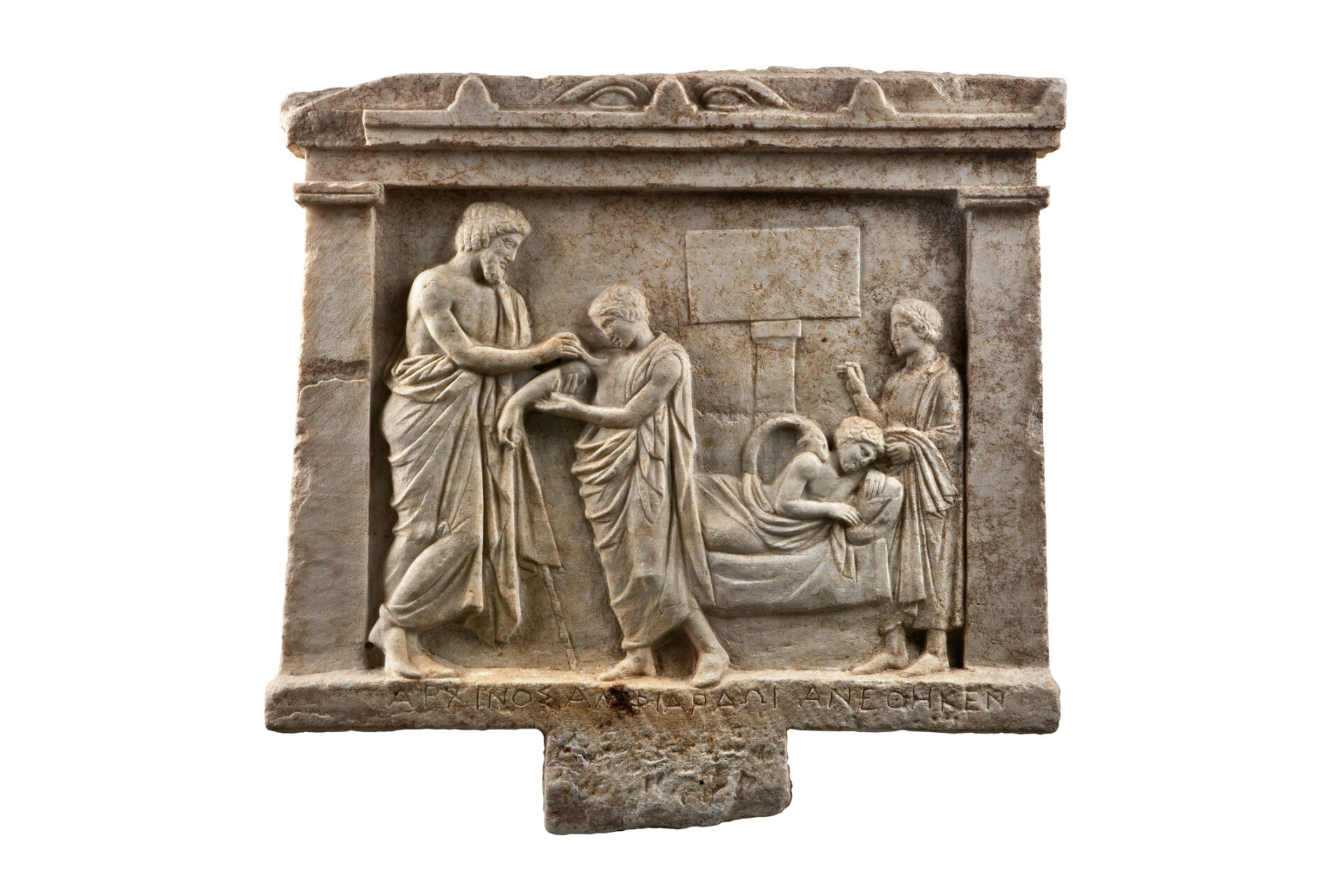Exhibit of the month
The grateful patient
Votive relief from the sanctuary of Amphiaraos at Oropos
National Archaeological Museum
Sculpture Collection, inv. no. Γ 3369
Dimensions: Height 0.49 m., width 0.54 m.
Date: First half of the 4th c. BC
Display: Room 26
On the famous relief from the sanctuary of the healing god Amphiaraos at Oropos we see three snapshots from the consecutive stages of religious healing in ancient sanctuaries. At the right the worshiper enters the sanctuary praying. Next, the patient sleeps in the sleeping chamber (Enkoimeterion), while a snake, an imaginary incarnation of the god, heals him by biting. In the foreground, Amphiaraos, depicted as a physician, treats the aching shoulder. The worshiper leaves himself in the god’s hands in trust.
Inscriptions, texts and sculptures offered to healing deities as return gifts for the cure of patients highlight the organization of their cult. The healing procedure – mainly in the numerous Asklepieia – comprised the following stages: purification, sacrifice, ritual meal, healing sleep and giving of thanks. Before becoming worthy of the main magical therapy, the worshiper was purified by water. Purification was followed by sacrifice. After his communion of the body of the god, the patient could transcend to the last phase of the healing process and sleep in the Enkoimeterion, where he waited for the god’s appearance. The enkoimesis, i.e. the healing sleep, is known from epigraphical sources and other votive reliefs.
Amphiaraos, who was initially a king-warrior of the Boeotians, moved in Oropos, where a famous healing sanctuary and oracle was established. He is here depicted similarly to Asklepios, the healing god par excellence.
From the inscription on the base of our relief, we are informed of the name of the patient and votary. He is Archinos, who gave Amphiaraos this sculpture in gratitude and recognition of his cure. Two eyes, warding off any future illness, look at the viewer. The figure of Archinos, who is depicted three times on the relief, highlights that healing was a very personal matter. In fact, a network of special sanctuaries related to healing was established especially after the early 5th c. BC.
Archinos plays a leading part in the depiction of the procedure of his healing. His figure, emphatically underlined on the relief, is the embodiment of the expectation of healing – which led the crowds to the sanctuaries – and of the gratitude for the happy outcome of the illness. Through faith and self-suggestion, simple people but also great personalities found hope and relief in the sanctuaries of the healing gods, resembling a miracle .
Dr Ariadne Klonizaki
BIBLIOGRAPHY
Leonardos, V., 1916, «Αμφιαρείου σκαφαί», AEphem 1916, 118-121.
Herzog, R. 1931., Die Wunderheilungen von Epidauros: ein Beitrag zur Geschichte der Medizin und der Religion, vol. 22, Philologus, Supplementband 3, Leipzig, 88 ff.
Hausmann, U., 1948. Kunst und Heiltum: Untersuchungen zu den griechischen Asklepiosreliefs, Potsdam, 55-58, no. 31.
Petrakos, V., 1968. Ο Ωρωπός και το Ιερόν του Αμφιαράου, Athens, 122, no. 18, pl. 40α.
Mitropoulou, E., 1977. Corpus I, Attic Votive Reliefs of the 6th and 5th Centuries B.C., Athens, 201.
Neumann, G., 1979. Probleme des Griechischen Weihreliefs, Tübingen, 51, pl. 28.
Van Straten, F., 1981. “Gifts for the Gods”, in H.S. Versnel (ed.), Faith, Hope and Worship: Aspects of Religious Mentality in the Ancient World 2:65-151, Studies in Greek and Roman Religion, Brill Archive, Appendix A, 16.1.
Kaltsas, Ν., 2001. Εθνικό Αρχαιολογικό Μουσείο. Τα Γλυπτά. Κατάλογος, Athens, 209-210, no. 425.
Versnel, H., 2011. Coping with the Gods: Wayward Readings in Greek Theology, vol. 173, Religions in the Graeco-Roman World, Leiden, 405-406.
Despinis, G., 2013. Μικρές μελέτες για ανάγλυφα: συγκολλήσεις και συσχετισμοί θραυσμάτων νέες παρατηρήσεις και ερμηνείες, Athens, 78-79.
Renberg, G., 2017. Where Dreams May Come: Incubation Sanctuaries in the Greco-Roman World, Lam edition, vol. 2, Religions in the Graeco-Roman World 184, Leiden, Boston, 650, no. VIII.2, fig. 53.


